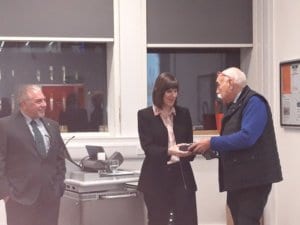The cart is empty!
Pipework Corrosion- Prediction and Reality
Dr Patrica Conder receiving a token of appreciation from Trevor Osborne, together with Paul Barnes, branch chairman
The January talk of ICorr London branch by Dr Patricia Conder, Sonomatic Ltd, was on “Pipework Corrosion : Prediction and Reality”, and how differences in the spatial pattern of internal pipework corrosion, be it patchy or more uniform, impacts on the effectiveness of inspection, and how this can be used to improve understanding of the underlying corrosion behaviour.
Patricia, discussed how extensive corrosion is easy to find and measure but, in instances where wall loss occurs more randomly, the challenges of matching inspection strategy to the corrosion coverage increase. She discussed how thinking of inspection of as a statistical sampling process helps both inspection strategy and analysis. The audience were challenged to spot the difference between a corroding and non-corroding circuit within a second. This was successfully achieved by means of a graphical overview of the whole circuit inspection history.
This overview presents a route to mine into the data, to examine “groupings” based on corrosion mechanisms, for example testing to see if the bends really are corroding faster than the straights. She also discussed the use of integrity driven corrosion rates, based on how the overall wall loss of the circuit is changing, rather than focusing on per inspection location corrosion rates, which can exaggerate measurement variability. Although historically inspection has been based on manual ultrasonic thickness measurements and radiography, these techniques have only covered relatively small areas overall. Developments for pipework inspection offer everything from screening to more detailed high accuracy mapping. The challenges being to incorporate all these results into a database in a meaningful way to get added value from a change in inspection approach. Patricia finished the talk by reminding us to think corrosion: think spatial.

